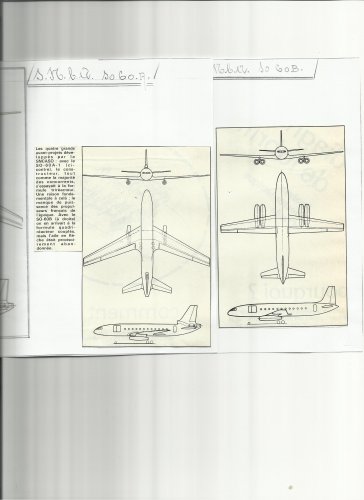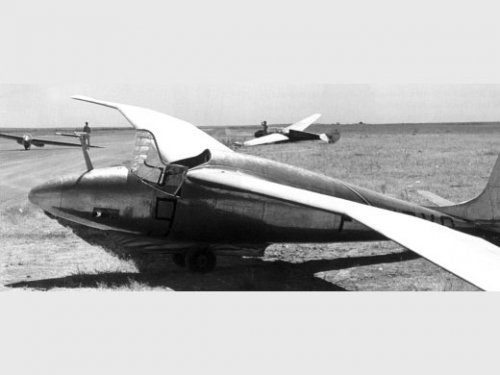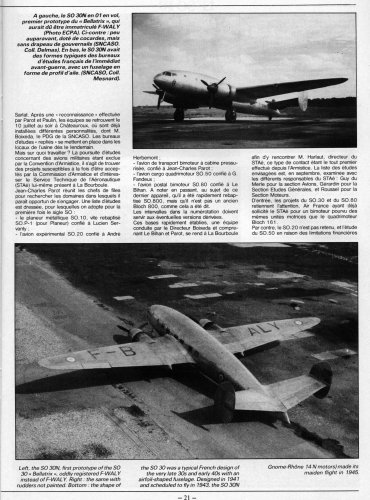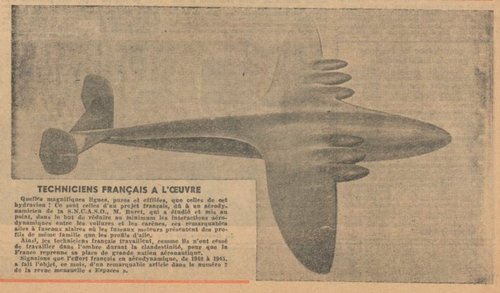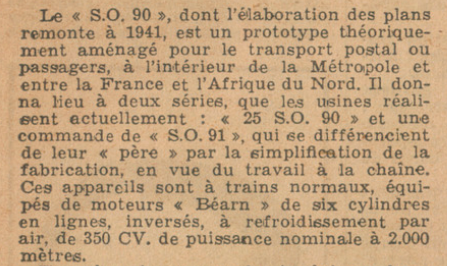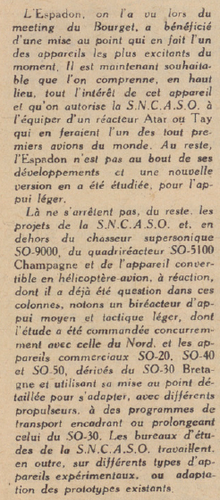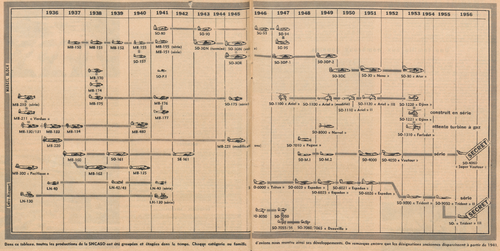- Joined
- 25 June 2009
- Messages
- 14,749
- Reaction score
- 6,112
SNCASO (Société nationale des constructions aéronautiques du sud-ouest, or commonly, Sud-Ouest) was a French aircraft manufacturer, which originated on November 16, 1936, from the merger of the factories of Blériot of Suresnes, Bloch of Villacoublay and Courbevoie, SASO (Société Aéronautique du Sud-Ouest) of Bordeaux-Mérignac, UCA (Usine de Construction Aéronautique) of Bordeaux-Bègles, SAB (Société Aérienne Bordelaise) of Bordeaux-Bacalan and Lioré et Olivier of Rochefort. Additionally, SNCASO built a factory in Déols in 1936. SNCASO took over SNCAO's assets in 1941. On March 1, 1957, SNCASO merged with SNCASE (Société nationale de constructions aéronautiques du sud-est), to form Sud Aviation (Source: Wikipedia).
This list is a work in progress. Information will soon be added next to the designations. If you see any mistake or omission, feel free to say so! The list will be updated accordingly.
SO 10 formerly known as the Bloch MB 1010
SO 11 formerly known as the Bloch MB 1011
SO 20 formerly known as the Bloch MB 1020
SO 30N Bellatrix twin-engined mid-wing transport with Gnome & Rhône 14N-49 engines, formerly known as as the Bloch MB 1030 (1 built)
SO 30R Bellatrix variant with Gnome & Rhône 14R-5 engines (2 built)
SO 30P.1 Bretagne, production version with Pratt & Whitney R-2800-B43 engines (30 built)
SO 30P.2 Bretagne, production version with Pratt & Whitney R-2800-CA13 engines (10 built)
SO 30C twin-engined cargo transport (1 built)
SO 30 "Nene" experimental twin-jet variant (1 built)
SO 30 "Atar" experimental twin-jet variant (1 conversion)
SO 31P planned variant
SO 33 planned high-wing, single-fin variant (not built)
SO 40 formerly known as the Bloch MB 1040
SO 60A swept low wing airliner project with three Atar 101 (different layouts studied) (not built)
SO 60B unswept low wing variant with four jet engines (not built)
SO 60C jet airliner project (Caravelle competitor) with two Atar engines and two Marboré boosters (not built)
SO 70 long-range transatlantic airliner project (not built)
SO 71 heavy bomber project for 1944/45 B6/R6 competition (not built)
SO 72 cargo version of SO.70 (not built)
SO 80 formerly known as the Bloch MB 800
SO 90 Cassiopée, twin-engined 8-passenger transport started as the Bloch MB 900; powered by 325 hp Bearn 6D-07 engines (3 built)
SO 91 planned version of SO.90 with tricycle undercarriage (not built)
SO 93 Corse, prototype powered by Renault 12S engines (1 built)
SO 94 Corse I, production 10 passenger version (15 built)
SO 94R Corse, radar training conversion of S.O.94
SO 95 Corse II, production 13-passenger version with tail-wheel undercarriage, all delivered to the military as S.O.95M (45 built)
SO 96 turbojet-powered version (not built)
SO 161 designation sometimes found for the Bloch 161 / SE 161
SO 175B variant of the Bloch 175
SO 177 variant of the Bloch 175 fighter re-engined with two 860 hp Hispano-Suiza 12Y-31 engines
SO 200C.1 was SNCAO.200
SO 830 project with retractable gear, no details
SO 1010 dive bomber project (not built)
SO 1020 dive bomber project (not built)
SO 1030 dive bomber project (not built)
SO 1040 also found as the SO 1014 (see under SO C.1)
SO 1070 twin-boom twin-engined attack aircraft project, became the NC 1070 (not built)
SO 1071 twin-engined attack aircraft project (not built)
SO 1072 twin-engined attack aircraft project (not built)
SO 1100 Ariel I two-seat experimental helicopter (1 built)
SO 1110 Ariel II (2 built)
SO 1120 Ariel III three-seat experimental helicopter (1 built), also known as the Breguet 1120
SO 1220 Djinn uncovered single-seat light observation helicopter with rotors driven by compressed-air jets at the end of each blade (1 + 178 built)
SO 1221 Djinn two-seat light helicopter prototypes (5 built)
SO 1310 Farfadet gyrodyne type aircraft with tip-jet driven, three-bladed rotor, fixed wing and turboprop engine driving nose-mounted propeller (1 built)
SO 1340 compound helicopter project (not built)
SO 1350 compound helicopter project (not built)
SO 3020 led to SNCAN NC 3021 Belphégor
SO 3030 transatlantic aircraft project (not built)
SO 3050 commercial low-wing two-seater (1 built)
SO 4000 two-seat experimental medium bomber (1 built)
SO 4010 version of SO 4050 (not built)
SO 4015 design that led to the Vautour II (not built)
SO 4050 Vautour bomber, interceptor, and attack aircraft (3 prototypes + 6 pre-prod.)
SO 4050 Vautour IIA single-seat tactical support fighter-bomber (30 built)
SO 4050 Vautour IIB two-seat bomber version (40 built)
SO 4050 Vautour IIN all-weather two-seat interceptor (70 built)
SO 4054 Vautour variant (not built)
SO 4055 Vautour variant (not built)
SO 4058 Vautour variant (not built)
SO 4060 Super Vautour project (not built)
SO 4061 Super Vautour variant (not built)
SO 4062 Super Vautour variant (not built)
SO 4070 thre-engined ramjet-powered design (not built)
SO 4080 twin-engined ramjet-powered design (not built)
SO 5000 global courier aircraft project, a turboprop-powered forerunner of the Champagne (not built)
SO 5100 Champagne four jet airliner aircraft project (not built)
SO 6000J Triton first French jet aircraft, powered by a Junkers Jumo 109-004 engine (1 built)
SO 6000P Triton, production aircraft powered by a Rolls-Royce Nene 101 engine (3 built)
SO 6005 Triton planned trainer variant (not built)
SO 6020 Espadon single-seat fighter (2 built)
SO 6021 Espadon single-seat fighter, lighter variant (1 built)
SO 6025 Espadon single-seat fighter (1 conversion)
SO 6026 Espadon single-seat fighter (1 conversion)
SO 6100 Requin jet strike fighter project (not built)
SO 6150 Requin II jet strike fighter project (not built)
SO 6160 further development of the Requin, competing with the Bréguet Taon (not built)
SO 7010 Pégase small low-wing transport with two Mathis G8R engines driving a single propeller (1 built)
SO 7050 Deauville all-metal low/mid-wing two-seat light private/trainer aircraft with fixed tailwheel undercarriage (1 built)
SO 7055 Deauville same aircraft modified with Régnier engine (1 conversion)
SO 7056 Deauville version with Mignet engine (1 built)
SO 7060 Deauville three-seat version of SO-7055 (2 conversions)
SO 7100 Dogue twin-engined ground-attack aircraft (not built)
SO 8000 Narval carrier-borne twin-boom single-seat fighter (2 built)
SO 8010 Narval proposal to fit a Rolls-Royce Nene centrifugal-flow turbojet (not built)
SO 9000 Trident I mixed power experimental interceptor aircraft (2 built)
SO 9050 Trident II more powerful pre-production aircraft with two Dassault MD-30 Vipers and one SEPR 631 rocket (3 built)
SO 9050 Trident III variant with three Turboméca 'Gabizo' engines and one SEPR 632 rocket (3 built)
SO M.1 unpowered glider to test the configuration of the SO.4000 flown on to of the single Heinkel He 274 (1 built)
SO M.2 half-scale flying model of the SO.4000 powered with Rolls-Royce Derwent engine (1 built)
SO P.1 Ferblantine high-performance all-metal gull-wing glider (1 built)
SO C.1 small single-seat design probably derived from the Bloch MB 1011; also found as the SO 1014 or SO 1040 (not built)
SB-2 SNCASO-Bloch project?, no details
This list is a work in progress. Information will soon be added next to the designations. If you see any mistake or omission, feel free to say so! The list will be updated accordingly.
SO 10 formerly known as the Bloch MB 1010
SO 11 formerly known as the Bloch MB 1011
SO 20 formerly known as the Bloch MB 1020
SO 30N Bellatrix twin-engined mid-wing transport with Gnome & Rhône 14N-49 engines, formerly known as as the Bloch MB 1030 (1 built)
SO 30R Bellatrix variant with Gnome & Rhône 14R-5 engines (2 built)
SO 30P.1 Bretagne, production version with Pratt & Whitney R-2800-B43 engines (30 built)
SO 30P.2 Bretagne, production version with Pratt & Whitney R-2800-CA13 engines (10 built)
SO 30C twin-engined cargo transport (1 built)
SO 30 "Nene" experimental twin-jet variant (1 built)
SO 30 "Atar" experimental twin-jet variant (1 conversion)
SO 31P planned variant
SO 33 planned high-wing, single-fin variant (not built)
SO 40 formerly known as the Bloch MB 1040
SO 60A swept low wing airliner project with three Atar 101 (different layouts studied) (not built)
SO 60B unswept low wing variant with four jet engines (not built)
SO 60C jet airliner project (Caravelle competitor) with two Atar engines and two Marboré boosters (not built)
SO 70 long-range transatlantic airliner project (not built)
SO 71 heavy bomber project for 1944/45 B6/R6 competition (not built)
SO 72 cargo version of SO.70 (not built)
SO 80 formerly known as the Bloch MB 800
SO 90 Cassiopée, twin-engined 8-passenger transport started as the Bloch MB 900; powered by 325 hp Bearn 6D-07 engines (3 built)
SO 91 planned version of SO.90 with tricycle undercarriage (not built)
SO 93 Corse, prototype powered by Renault 12S engines (1 built)
SO 94 Corse I, production 10 passenger version (15 built)
SO 94R Corse, radar training conversion of S.O.94
SO 95 Corse II, production 13-passenger version with tail-wheel undercarriage, all delivered to the military as S.O.95M (45 built)
SO 96 turbojet-powered version (not built)
SO 161 designation sometimes found for the Bloch 161 / SE 161
SO 175B variant of the Bloch 175
SO 177 variant of the Bloch 175 fighter re-engined with two 860 hp Hispano-Suiza 12Y-31 engines
SO 200C.1 was SNCAO.200
SO 830 project with retractable gear, no details
SO 1010 dive bomber project (not built)
SO 1020 dive bomber project (not built)
SO 1030 dive bomber project (not built)
SO 1040 also found as the SO 1014 (see under SO C.1)
SO 1070 twin-boom twin-engined attack aircraft project, became the NC 1070 (not built)
SO 1071 twin-engined attack aircraft project (not built)
SO 1072 twin-engined attack aircraft project (not built)
SO 1100 Ariel I two-seat experimental helicopter (1 built)
SO 1110 Ariel II (2 built)
SO 1120 Ariel III three-seat experimental helicopter (1 built), also known as the Breguet 1120
SO 1220 Djinn uncovered single-seat light observation helicopter with rotors driven by compressed-air jets at the end of each blade (1 + 178 built)
SO 1221 Djinn two-seat light helicopter prototypes (5 built)
SO 1310 Farfadet gyrodyne type aircraft with tip-jet driven, three-bladed rotor, fixed wing and turboprop engine driving nose-mounted propeller (1 built)
SO 1340 compound helicopter project (not built)
SO 1350 compound helicopter project (not built)
SO 3020 led to SNCAN NC 3021 Belphégor
SO 3030 transatlantic aircraft project (not built)
SO 3050 commercial low-wing two-seater (1 built)
SO 4000 two-seat experimental medium bomber (1 built)
SO 4010 version of SO 4050 (not built)
SO 4015 design that led to the Vautour II (not built)
SO 4050 Vautour bomber, interceptor, and attack aircraft (3 prototypes + 6 pre-prod.)
SO 4050 Vautour IIA single-seat tactical support fighter-bomber (30 built)
SO 4050 Vautour IIB two-seat bomber version (40 built)
SO 4050 Vautour IIN all-weather two-seat interceptor (70 built)
SO 4054 Vautour variant (not built)
SO 4055 Vautour variant (not built)
SO 4058 Vautour variant (not built)
SO 4060 Super Vautour project (not built)
SO 4061 Super Vautour variant (not built)
SO 4062 Super Vautour variant (not built)
SO 4070 thre-engined ramjet-powered design (not built)
SO 4080 twin-engined ramjet-powered design (not built)
SO 5000 global courier aircraft project, a turboprop-powered forerunner of the Champagne (not built)
SO 5100 Champagne four jet airliner aircraft project (not built)
SO 6000J Triton first French jet aircraft, powered by a Junkers Jumo 109-004 engine (1 built)
SO 6000P Triton, production aircraft powered by a Rolls-Royce Nene 101 engine (3 built)
SO 6005 Triton planned trainer variant (not built)
SO 6020 Espadon single-seat fighter (2 built)
SO 6021 Espadon single-seat fighter, lighter variant (1 built)
SO 6025 Espadon single-seat fighter (1 conversion)
SO 6026 Espadon single-seat fighter (1 conversion)
SO 6100 Requin jet strike fighter project (not built)
SO 6150 Requin II jet strike fighter project (not built)
SO 6160 further development of the Requin, competing with the Bréguet Taon (not built)
SO 7010 Pégase small low-wing transport with two Mathis G8R engines driving a single propeller (1 built)
SO 7050 Deauville all-metal low/mid-wing two-seat light private/trainer aircraft with fixed tailwheel undercarriage (1 built)
SO 7055 Deauville same aircraft modified with Régnier engine (1 conversion)
SO 7056 Deauville version with Mignet engine (1 built)
SO 7060 Deauville three-seat version of SO-7055 (2 conversions)
SO 7100 Dogue twin-engined ground-attack aircraft (not built)
SO 8000 Narval carrier-borne twin-boom single-seat fighter (2 built)
SO 8010 Narval proposal to fit a Rolls-Royce Nene centrifugal-flow turbojet (not built)
SO 9000 Trident I mixed power experimental interceptor aircraft (2 built)
SO 9050 Trident II more powerful pre-production aircraft with two Dassault MD-30 Vipers and one SEPR 631 rocket (3 built)
SO 9050 Trident III variant with three Turboméca 'Gabizo' engines and one SEPR 632 rocket (3 built)
SO M.1 unpowered glider to test the configuration of the SO.4000 flown on to of the single Heinkel He 274 (1 built)
SO M.2 half-scale flying model of the SO.4000 powered with Rolls-Royce Derwent engine (1 built)
SO P.1 Ferblantine high-performance all-metal gull-wing glider (1 built)
SO C.1 small single-seat design probably derived from the Bloch MB 1011; also found as the SO 1014 or SO 1040 (not built)
SB-2 SNCASO-Bloch project?, no details


